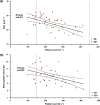Are coagulation profiles in Andean highlanders with excessive erythrocytosis favouring hypercoagulability?
- PMID: 38554124
- PMCID: PMC11140178
- DOI: 10.1113/EP091670
Are coagulation profiles in Andean highlanders with excessive erythrocytosis favouring hypercoagulability?
Abstract
Chronic mountain sickness is a maladaptive syndrome that affects individuals living permanently at high altitude and is characterized primarily by excessive erythrocytosis (EE). Recent results concerning the impact of EE in Andean highlanders on clotting and the possible promotion of hypercoagulability, which can lead to thrombosis, were contradictory. We assessed the coagulation profiles of Andeans highlanders with and without excessive erythrocytosis (EE+ and EE-). Blood samples were collected from 30 EE+ and 15 EE- in La Rinconada (Peru, 5100-5300 m a.s.l.), with special attention given to the sampling pre-analytical variables. Rotational thromboelastometry tests were performed at both native and normalized (40%) haematocrit using autologous platelet-poor plasma. Thrombin generation, dosages of clotting factors and inhibitors were measured in plasma samples. Data were compared between groups and with measurements performed at native haematocrit in 10 lowlanders (LL) at sea level. At native haematocrit, in all rotational thromboelastometry assays, EE+ exhibited hypocoagulable profiles (prolonged clotting time and weaker clot strength) compared with EE- and LL (all P < 0.01). At normalized haematocrit, clotting times were normalized in most individuals. Conversely, maximal clot firmness was normalized only in FIBTEM and not in EXTEM/INTEM assays, suggesting abnormal platelet activity. Thrombin generation, levels of plasma clotting factors and inhibitors, and standard coagulation assays were mostly normal in all groups. No highlanders reported a history of venous thromboembolism based on the dedicated survey. Collectively, these results indicate that EE+ do not present a hypercoagulable profile potentially favouring thrombosis.
Keywords: blood coagulation; chronic mountain sickness; excessive erythrocytosis; hypoxia; thromboelastometry.
© 2024 The Authors. Experimental Physiology published by John Wiley & Sons Ltd on behalf of The Physiological Society.
Conflict of interest statement
The authors declare no conflicts of interest.
Figures







References
-
- Bontekoe, I. J. , van der Meer, P. F. , & Korte, D. (2019). Thromboelastography as a tool to evaluate blood of healthy volunteers and blood component quality: A review. Vox Sanguinis, 114(7), 643–657. - PubMed
-
- Champigneulle, B. , Brugniaux, J. V. , Stauffer, E. , Doutreleau, S. , Furian, M. , Perger, E. , Pina, A. , Baillieul, S. , Deschamps, B. , Hancco, I. , Connes, P. , Robach, P. , Pichon, A. , & Verges, S. (2024). Expedition 5300: Limits of human adaptations in the highest city in the world. The Journal of Physiology, Advance online publication. 10.1113/jp284550 - DOI - PubMed
-
- Champigneulle, B. , Hancco, I. , Hamard, E. , Doutreleau, S. , Furian, M. , Brugniaux, J. V. , Bailly, S. , & Vergès, S. (2022). Excessive erythrocytosis and chronic mountain sickness in the highest city in the world: A longitudinal study. Chest, 161(5), 1338–1342. - PubMed
MeSH terms
Substances
Grants and funding
LinkOut - more resources
Full Text Sources
